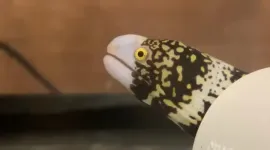(Press-News.org) When sailing along on the seas and you suddenly spot a porpoise's fin in the distance, chances are that you have only encountered a single animal. Porpoises are most often seen alone, but new research now suggests that they also roam in groups - and even enter into a sophisticated collaboration when hunting.
The way they collaborate surprises us, because the common perception among biologists is that porpoises roam and hunt alone, says Associate Professor Magnus Wahlberg, who is an expert in marine mammals and heads the Marine Biological Research Centre at the University of Southern Denmark (SDU).
Drone footage has revealed group hunting among porpoises coming together to hunt schools of fish.
The research team has recorded almost 44 hours of drone footage from the waters around Funen, corresponding to 159 hunting sequences. In 95 of these, between two and six adult porpoises participated. The researchers expected to see the porpoises hunting alone. And if it turned out that several porpoises were in fact hunting together, the researchers expected that it would be an unstructured hunt without no cooperation whatsoever between the individual animals.
Instead, a seemingly solitary animal has turned out to be more social than previously thought, says PhD student Sara Torres Ortiz, who was at SDU when the research was conducted but is now at the Max Planck Institute for Ornithology in Germany. She researches animal cognition.
The footage also shows porpoises hunting alone. According to the researchers, solitary hunters are less successful at foraging food than the porpoises that hunt in groups.
In order to hunt in the observed way, the porpoises must be able to share information and coordinate their actions. They take on different roles during the hunt, and the drone footage has revealed six different roles:
The distant gatherer (far bordering) swims around the school of fish at a distance of at least three body lengths.
The close gatherer (close bordering) swims around the school of fish at a distance closer than three body lengths and with its body and head parallel to the school of fish.
The shepherd (herding fish) swims close to the school of fish and influences its direction.
The splitter (cross school) swims through the school
The spear (hunting attempt) swims directly into the school at high speed
Swimming away - swims away from the school.
Each porpoise can take on different roles during the hunt, and the result of the collaboration is that the school of fish eventually becomes so confused and exhausted that the individual hunters are able to capture the fish that stray away from the school.
There are several different types of group hunting in the animal kingdom. The form observed can be called a form of collaborative hunting, and it is more sophisticated than the form called cooperative hunting, explains Sara Torres Ortiz.
Animals such as chimpanzees and raves exhibit cooperative hunting abilities. During this form of hunting, several hunters gather without taking on different roles.
The collaborative hunt, in which the individual hunters take on different roles, is more rare - or, rather: It is not observed very often because it is inherently difficult to follow. The use of drones opens up new possibilities of following a herd of animals from above - like this porpoise study - and this may in the future contribute with new and improved knowledge about hunting animals.
Until now, collaborative hunting has been scientifically described in animals such as lions, fossas, wolves and jackals. Wolves and jackals divide the hunting pack into two teams, where one team lurks while the other team drives the prey forward. Among lions, the strategy is for the entire pack to approach the prey from different directions, after which some hunters lie down to hide while the rest of the group drives the prey towards them.
Sea-dwelling predators are extra difficult to observe, meaning researchers cannot say with certainty whether animals like killer whales and dolphins hunt cooperatively and/or collaboratively. However, several researchers have observed complex hunting behaviours in killer whales and dolphins. For example, killer whales have been seen making waves that push seals off ice floes.
What other surprises await?
The drone footage now raises new questions:
Does the hunting group consist of the same individuals every time, or is it randomly composed? How often do participants change roles? And do porpoises enter into other social relations with each other?
- Drones have truly changed the possibilities of studying marine animals, and it will be exciting to see if they can surprise us again, says Sara Torres Ortiz.
INFORMATION:
The study is published in the Canadian Journal of Zoology.
The work is supported by SDU's Lighthouse Initiative, the Swedish Royal Academy of Sciences, the Royal Physiographic Society in Lund and the Lars Hierta Memorial Foundation.
Men who suffer sensory loss, particularly hearing loss, are more likely to be physically inactive and obese than women, according to a new study published in the European Journal of Public Health.
Researchers analysed data from more than 23,000 Spanish adults, and examined associations with physical inactivity and obesity in people with vision and hearing loss, and explored differences between men and women.
Results suggest inactive people with hearing loss were 1.78 times more likely to be obese compared to those who did not have any hearing loss. In people who had difficulty seeing, the odds ratio is slightly smaller, with a likelihood ...
Systematic literature review provides evidence base for new therapeutic avenues in vasculitis
Researchers have reviewed all clinical trials of targeted drugs used in the treatment of vasculitis. With this, they propose a completely mechanistic categorisation of these diseases, which may in time provide better treatment.
Diseases which cause inflammation of the blood vessels are presently categorised according to the size of the blood vessels involved. But it would make more sense - and ultimately end with better treatment - if the diseases were categorised based on the causes of the inflammation.
This is shown by a systematic literature review of clinical trials in vasculitis, which researchers from Aarhus ...
Astrophysicists from the University of Bath have developed a new method for pinpointing the whereabouts of extremely rare extragalactic objects. They hope their technique for finding 'changing-look quasars' will take scientists one step closer to unravelling one of greatest mysteries of the universe - how supermassive black holes grow. Quasars are believed to be responsible for regulating the growth of supermassive black holes and their host galaxies.
A quasar is a region of spectacular luminosity at the centre of a galaxy, powered by a supermassive black hole - the largest type of black hole, with a mass that exceeds that of our sun by millions or billions. There is a supermassive black hole ...
When it comes to climate change, policymakers may fail to see the trees for the forest. Turns out that the trees may be the answer after all, according to a study published by authors from more than seven countries on June 3rd in Nature Climate Change.
"Climate change and biodiversity loss are two major environmental challenges," said paper author Akira S. Mori, professor at Yokohama National University. "But the vast majority of attention has been paid to one unidirectional relationship -- climate change as a cause and biodiversity loss as a consequence."
Mori and his co-authors argue that climate change and species ...
Tuesday, 8 June 2021: A study by RCSI indicates that exercise is probably the most effective short-term treatment for depression in people with coronary heart disease, when compared to antidepressants and psychotherapy or more complex care.
The study, led by researchers at RCSI University of Medicine and Health Sciences, is published in the June edition of Psychosomatic Medicine.
This is the first systematic review to compare treatments for depression in those with coronary disease and the findings provides valuable clinical information to help doctors determine the best treatment plan for patients.
The researchers reviewed treatment trials which investigated antidepressants, psychotherapy, ...
Around the globe, software-intensive organisations shift from plan-based development processes to Agile ones, intending to focus more on team interaction, better products, customers' needs, and readiness to change.
But how do these organisations succeed with large-scale Agile software transformations - and how do the success factors relate? This has been discussed in the scientific community for several years. Now, Associate Professor Daniel Russo from Department of Computer Science, Aalborg University presents a long-term study, which sheds even more light on the ...
Rising unemployment, inadequate benefits and low paid work are the main causes of poverty and destitution in Stoke-on-Trent according to the findings of a new study.
The research carried out by Staffordshire University and Citizens Advice Staffordshire North & Stoke-on-Trent, and funded through Research England's Strategic Priorities Fund, aims to understand the impact COVID-19 is having on residents in the city.
The report includes case studies of people who have turned to Citizens Advice and Alice Charity's Foodbank after finding themselves unable to work through the pandemic and facing increasing debt or struggling to claim benefits.
Post ...
Lanthanides are rare-earth heavy metals with useful magnetic properties and a knack for emitting light. Researchers had long assumed that lanthanides' toxicity risk was low and therefore safe to implement in a number of high-tech breakthroughs we now take for granted: from OLEDs (organic light-emitting displays)¬¬ to medical MRIs and even hybrid vehicles.
In recent years, however, some scientists have questioned lanthanides' safety. In matters concerning health care, for example, some MRI patients have attributed a litany of side effects, including ...
Most fish rely on water to feed, using suction to capture their prey. A new study, however, shows that snowflake morays can grab and swallow prey on land without water thanks to an extra set of jaws in their throats.
After a moray eel captures prey with its first set of jaws, a second set of "pharyngeal jaws" then reaches out to grasp the struggling prey and pull it down into the moray's throat. Rita Mehta, an associate professor of ecology and evolutionary biology at UC Santa Cruz, first described this astonishing feeding mechanism in a 2007 Nature paper.
The new study, published June 7 in the Journal of Experimental Biology, shows that these pharyngeal jaws enable ...
Forty years ago, the first cases of HIV/AIDS in the U.S began to raise public awareness- but new research highlights the struggle people living with the disease still face against stigma, discrimination and negative labelling in their own families, communities and even amongst healthcare professionals.
A new study by Flinders University researchers interviewed 20 HIV healthcare providers including doctors, nurses, and counsellors in Yogyakarta and Belu districts, Indonesia to examine their experiences when treating patients with HIV. Their responses indicated admission of ...



